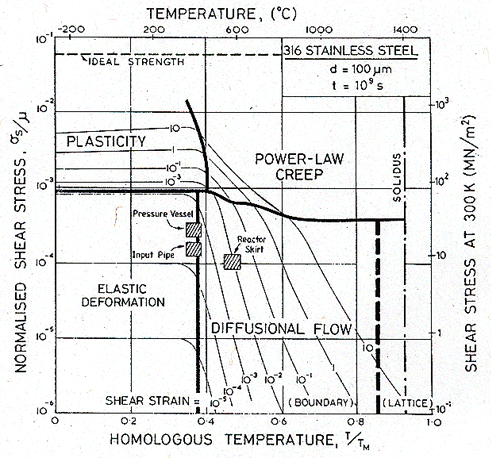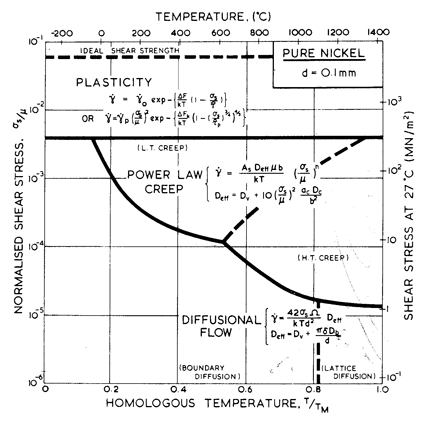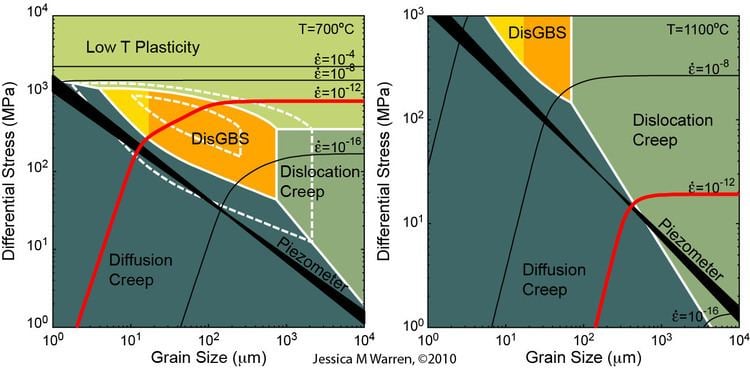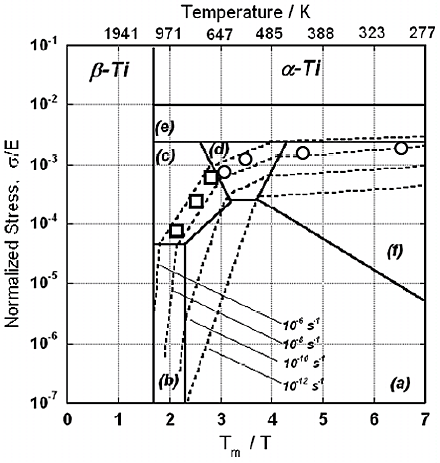 | ||
Similar Deformation monitoring, Thick skinned deformation, Severe plastic deformation | ||
A deformation mechanism map is a way of representing the dominant deformation mechanism in a material loaded under a given set of conditions and thereby its likely failure mode. Deformation mechanism maps usually consist of some kind of stress plotted against some kind of temperature axis, typically stress normalized using the shear modulus versus homologous temperature with contours of strain rate. For a given set of operating conditions calculations are undergone and experiments performed to determine the predominant mechanism operative for a given material. Constitutive equations for the type of mechanism have been developed for each deformation mechanism and are used in the construction of the maps. The theoretical shear strength of the material is independent of temperature and located along the top of the map, with the regimes of plastic deformation mechanisms below it. Constant strain rate contours can be constructed on the maps using the constitutive equations of the deformation mechanisms which makes the maps extremely useful.
Contents

Deformation Maps can also be constructed using any two of stress (normalized), temperature (normalized) and strain rate, with contours of the third variable. A stress/strain rate plot is useful because power-law mechanisms then have contours of temperature which are straight lines.

Deformation mechanism Maps should not be confused with the similar but distinct Failure Mechanism maps, which were also first developed by Ashby.

Constructing the Map

Repeated experiments are performed to characterize the mechanism by which the material deforms. The dominant mechanism is the one which dominates the continuous deformation rate (strain rate), however at any given level of stress and temperature, more than one of the creep and plasticity mechanisms may be active. The boundaries between the fields are determined from the constitutive equations of the deformation mechanisms by solving for stress as a function of temperature.
Reading the Map

For a given stress profile and temperature, the point lies in a particular "deformation field". If the values place the point near the center of a field, it is likely that the primary mechanism by which the material will fail, i.e.: the type and rate of failure expected, grain boundary diffusion, plasticity, Nabarro-Herring creep, etc... If however, the stress and temperature conditions place the point near the boundary between two deformation mechanism regions then the dominating mechanism is less clear. Near the boundary of the regimes there can be a combination of mechanisms of deformation occurring simultaneously. Deformation mechanism maps are only as accurate as the number of experiments and calculations undertaken in their creation.
For a given stress and temperature, the strain rate and deformation mechanism of a material is given by a point on the map. By comparing maps of various materials, crystal structures, bonds, grain sizes, etc., studies of these materials properties on plastic flow can be conducted and a more complete understanding of deformation in materials is obtained.
Examples of Deformation Mechanisms
Above the theoretical shear strength of the material, a type of defect-less flow can still occur, shearing the material. Dislocation motion through glide (any temperature) or creep (at high temperatures) is a typical mechanism found at high stresses in deformation maps. Diffusional flow is a regime typically below dislocation creep and occurs at high temperatures due to the diffusion of point defects in the material. Diffusional flow can be further broken down into more specific mechanisms: Nabarro-Herring creep, Coble creep and Harper-Dorn creep. These mechanisms and their constitutive equations are described in this article.
Creep, a mode of material failure which often requires experimental evidence to construct empirical models of its behavior, is often represented by a deformation mechanism map. Data from measurements at various levels of stress and temperature are plotted, often with constant strain rate contours included. The map may then be useful to predict one of temperature, stress, and creep strain rate, given the other two.
